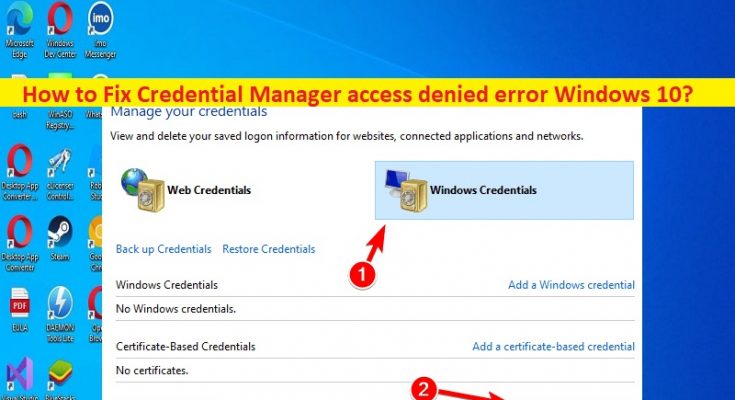Tips to fix Credential Manager access denied error in Windows 10/11:
In this post, we are going to discuss on How to fix Credential Manager access denied error in Windows 10/11. You are provided with easy steps/methods to resolve the issue. Let’s starts the discussion.
‘Credential Manager access denied error’:
‘Credential Manager’: Credential Manager allows you to view and delete your saved credentials for signing in to websites, connected applications, and networks. It is designed & developed to store your login data that has never been simpler, since now you don’t have to remember any account names or passwords. It represents an in-built feature located within the Windows 10 internal systems. This feature is used by Internet Explorer and by other browsers in order to store usernames and passwords for various websites and accounts.
However, several users reported they faced Credential Manager access denied error when they tried to access Credential Manager in Windows 10/11 computer. There could be several reasons behind the issue including incorrect or bad configured IP settings, incorrect settings relating to Credential Manager, issue with network profile, issue with group policy settings relating to Credential Manager, and other issues. Let’s go for the solution.
How to fix Credential Manager access denied error in Windows 10/11?
Method 1: Fix Credential Manager access denied error with ‘PC Repair Tool’
‘PC Repair Tool’ is easy & quick way to find & fix BSOD errors, DLL errors, EXE errors, problems with programs/applications, malware or viruses infections in computer, system files or registry issues, and other system issues with just few clicks.
Method 2: Turn off password protected sharing
One possible way to fix the issue is to disable password protected sharing.
Step 1: Press ‘Windows + R’ keys on keyboard, type ‘control.exe /name Microsoft.NetworkAndSharingCenter /page Advanced and hit Enter. Advanced Sharing settings’ in ‘Run’ window and hit ‘Ok’ button to open
Step 2: In ‘Advanced Sharing Settings’ window, click ‘All Networks’ and under ‘Password Protected Sharing’, select ‘Turn OFF password protected sharing’ and click ‘Save Changes’
Step 3: Close ‘Advanced Sharing Options’ tab and restart your computer and check if the issue is resolved.
Method 3: Change Internet Options

Step 1: Press ‘Windows + R’ keys on keyboard, type ‘inetcpl.cpl’ in ‘Run’ window and hit ‘Ok’ button to open ‘Internet Properties’ window.
Step 2: Press ‘Content’ tab and within ‘Auto Complete’ section, click ‘Settings’, uncheck all options and click ‘Ok’ to save changes
Step 3: Click ‘Settings’ button and enable all options and click ‘Ok’ to save the changes.
Step 4: Now, go to ‘General’ tab and click ‘Delete’ from ‘Browsing history’ section. Once the cache is cleared, restart your computer and check if the issue is resolved.
Method 4: Fix Credential Manager access denied error using Registry Editor?

Step 1: Press ‘Windows + R’ keys on keyboard, type ‘regedit’ in ‘Run’ window and hit ‘Ok’ button to open ‘Registry Editor’ and go to following path.
HKEY_CURRENT_USERSoftwareMicrosoftInternet ExplorerMain
Step 2: Go your attention towards the right panel of registry editor and from there, select ‘FormSuggest PW’ string, right-click on same and select ‘Edit String’. In Value Data filed enter ‘Yes’.
Step 3: Close the registry editor and restart your computer and check if it works for you.
Method 5: Change ownership for vault directory

Step 1: Open ‘File Explorer’ and go to ‘C: > ProgramData’ folder and go to ‘Microsoft > Vault’
Step 2: Right-click ‘Vault’ folder and select ‘Properties’. Click ‘Security’ tab and click ‘Advanced’ and click ‘Change Permissions’ button
Step 3: Check ‘Replace all child object permissions entries’ and click ‘Apply > Ok’ button to save the changes.
Step 4: After that, find and right-click ‘AC658CB4-9126-49BD-B877-31EEDAB3F204’ folder and select ‘Properties’
Step 5: Go to ‘Security’ tab and click ‘Advanced’ button. Under ‘Owner’ section, click ‘Change’
Step 6: In ‘Enter the object name to select’ field and enter ‘Administrators’
Step 7: Click ‘Check Names’ and if everything is in order, click ‘Ok’ button
Step 8: Check ‘Replace owner on subscontainers and objects’, click ‘Replace all child object permission entries’ and click ‘Apply > Ok’ to save the changes.
Method 6: Set Credential Manager service to automatic
Step 1: Open ‘Services’ app in Windows PC via Windows Search Box
Step 2: Find and double-click ‘Credential Manager’ to open its Properties. Select ‘Automatic’ from ‘Startup Type’ dropdown, and then click ‘Apply > Ok’ button to save the changes.
Method 7: Enter the credentials manually in Credential Manager
Step 1: Type ‘Credential Manager’ in Windows Search Box and open it from results appear
Step 2: When Credential Manager starts, make sure that Windows Credentials is selected. Click ‘Add a generic credentials’, enter required information and click ‘Ok’ to save the changes.
Method 8: Use Microsoft Edge to change saved passwords in Credential Manager
Step 1: Open ‘Microsoft Edge’ and go to ‘Settings’
Step 2: Scroll down and in Advanced settings section, click ‘View Advanced Settings’
Step 3: Scroll down to ‘Privacy and Services’ section, click ‘Manage Passwords’. A list of saved password will appear. Click on any saved entry to change it, change username or password and click ‘Save’
Method 9: Use the IP address of device
If you are unable to access network drive, you might have to make a few changes in Credential Manager. You create new credentials but be sure to use IP address of the device in credential creation process, enter username and password and the issue should be resolved.
Method 10: Delete ‘Protect’ folder
Step 1: Press ‘Windows + R’ keys on keyboard, type ‘%AppData%’ in ‘Run’ window and hit ‘Ok’ button
Step 2: In the opened folder, find go to ‘MicrosoftProtect’ folder, select all files and delete them. Once done, check if it works for you.
Conclusion
I am sure this post helped you on How to fix Credential Manager access denied error in Windows 10 with easy ways. You can read & follow our instructions to do so. That’s all. For any suggestions or queries, please write on comment box below.



